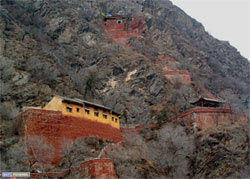
Temples on Wutai Shan. The Sixth Dalai Lama once studied here, now known as ‘Guanyin Cave’. The Thirteenth Dalai Lama also prayed here.
The damage is so severe in places that locals are reportedly saying that the mountain, whose name translates as ‘five terraces mountain’ will soon be known as ‘four terraces mountain’. The Chinese government has applied to have Wutai Shan listed as the World Cultural Heritage and the World Natural Heritage lists of the United Nations Educational, Scientific and Cultural Organisation this year (China Daily, January 3, 2007).
The report by United Daily News on June 22, 2007 states that due to blasting by mining companies, there is extensive damage to a stretch of valley between the west and central peaks; another peak between the south and west peaks has almost been ‘leveled’, and statues at a Buddhist monastery close to one of the mining areas have been lost. On May 18, a road to Mount Wutai was closed after a 100-plus-meter high dam of a mining company collapsed and caused a mud and rock flow (Xinhua, May 19).
The National Commission of the People’s Republic of China draws attention to the rich mineral resources of the area as part of its submission for World Heritage status, saying: “…Furthermore, treasures spread out all over Mount Wutai, especially the rich mineral resources. In addition to the abundant iron ore, it has considerable deposits of copper ore, gold ore, molybdenum ore and so on. Hence it has great science researching value. It has always been the place cherished by the geologist at home and abroad.”
United Daily News reported: “A villager who grazes sheep on the mountain slopes said there are now three explosions every day, and that it’s like an earthquake when the explosions go off. Shi Guangji, the abbot of Jin’ge Monastery, said that there was an explosion in 2005 which threw him from his chair. He said that three statues in the northwest hall [of the monastery] collapsed last year, and now the only way was to make them heavier and reinforced with cement – ‘The statue of Buddha sits on a concrete plinth.’ The Lingxiaobao Hall at Jin’ge Monastery spans the Ming and Qing Dynasties. A monk, Shi Beiteng said that when he entered the monastery five years ago it was perfect, but now there are cracks running through the wall frescoes in the hall, and one crack had split a frescoed wall into two halves, and that you can see light from outside coming through the crack.”
There is less and less plant cover on the mountain, revealing numerous caves and pits caused by mining excavations. According to the report in the Taiwanese newspaper, some of the caves are big enough for two large machines to operate side by side.
A $60 million relocation project was launched by the provincial authorities in Shanxi last October in order to “restore the serenity” of the Buddhist mountain as part of its bid for the mountain to gain UNESCO World Heritage status (China Daily, March 1). Under the scheme, commercial buildings were to be pulled down about 1,000 residents relocated.
Reuters reported earlier this month that hundreds of Tibetans protested to the authorities to stop the exploitation of a mountain they consider sacred, Yala mountain, for the mining of lead and zinc. The incident took place in Tawu County, Kardze (Chinese: Ganzi) Prefecture in Sichuan province, the Tibetan area of Kham. Tibetans apparently smashed cars during a protest outside the local branch of a mining company in late May. A number of arrests followed although reports of deaths could not be confirmed.

